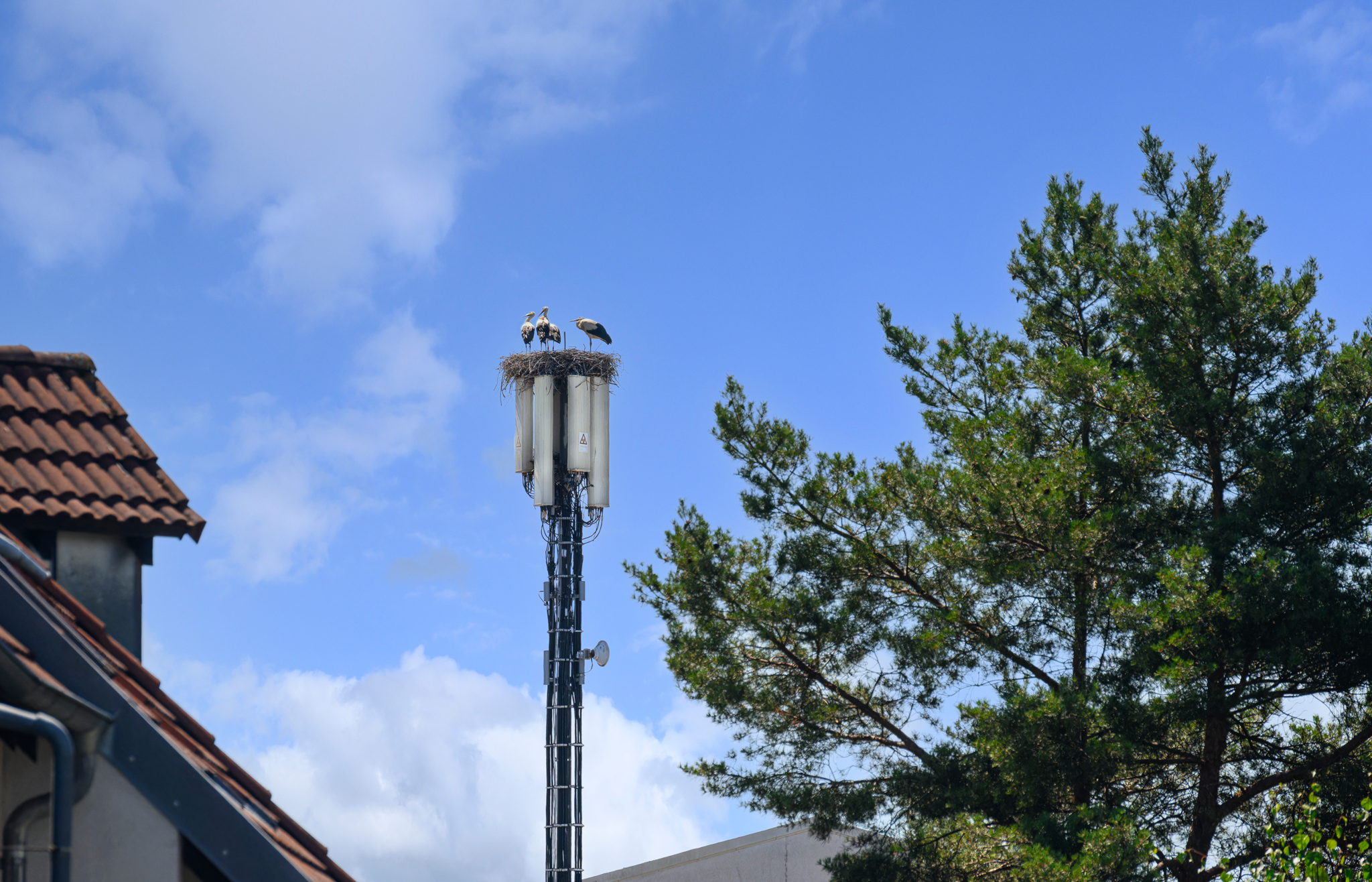The energy consumption of 5G and 6G networks could increase dramatically in the future. Therefore, a team at Fraunhofer IIS is researching how to give mobile communication networks their own sleep rhythm. It’s called “network energy savings”. But what exactly does that mean?
What mobile communications can do to protect the climate
September 5, 2024 | Less energy consumption thanks to Network Energy Saving
If sleep didn’t already exist, it would have to be invented. Night after night, people enter this temporary state of unconsciousness, which shuts down the body externally in order to repair it internally, rationing its resources so that they can be deployed all the more intensively later. Emotions are processed, new information is solidified, superfluous odds and ends are cleared out before the alarm clock buzzes and people start the new day with renewed vigor. The whole process is a marvel of efficiency – and a source of inspiration that could soon make mobile communications climate neutral.
Mobile communications, sleep, and saving the planet – at first glance, these three things don’t seem to have much in common. Anyone willing to take a second look should talk to Elke Roth-Mandutz. With her doctoral thesis, she was once among those who dedicated themselves to the idea of sustainable mobile communications under the heading of “self-organizing networks”. This was at a time when the LTE generation was in the offing, and research had concluded that wireless networks were consuming far too much energy. For a short time, it seemed as though things might actually move in the right direction. “But then energy prices fell again and the proposals couldn’t find any takers,” Roth-Mandutz recalls. As the momentum fizzled out, the scientific debates retreated behind the walls of theory.
Plenty of progress, plenty of energy
When the issue landed back on her desk a few years later, a lot had changed. Not only for Roth-Mandutz herself, who’s now one of the two managers for the Mobile Communications group at Fraunhofer IIS, but above all in the political and social environment. Warning forecasts, the Paris climate agreement, the European Green Deal; new goals, new expectations, new hopes. People around the world are working on technological solutions to neutralize CO₂ emissions by the year 2050. The window for action is open again, but the pressure to act is all the greater.
The mobile communications sector is growing rapidly worldwide. While the 5G standard is currently being established, the next beacon of hope is already shimmering on the technology horizon: 6G. It’s clear that the new generations mean more progress – more connectivity, more services, more applications. But every intelligent vehicle, every pair of virtual reality glasses, every digital twin also means more energy consumed, more greenhouse gases emitted. “If we don’t act now, global electricity consumption will go irrevocably through the roof in the 2030s,” Roth-Mandutz says.
Every solution begins with a search for the cause of the problem. A closer look at where the high energy consumption of mobile communications originates quickly reveals the responsible party: over 70 percent of electricity consumption in networks is due to base stations. This is because mobile phone masts are in a continuous state of hyperactivity. They’re usually wide awake, even when there are no devices nearby in need of their capacity. Energy is released, but not directed toward any purpose; it simply goes to waste. “That makes absolutely no sense,” Roth-Mandutz says, “especially as we can see enormous fluctuations in usage at many base stations.”
Particularly at night, when most smartphones go into standby mode for hours on end, data traffic calms down considerably. There’s also a local dimension: A mobile phone mast near a soccer stadium runs at peak operation over the weekend when the game’s on and thousands of spectators are cheering in the stands. During the week, on the other hand, it’s practically radio silence. So wouldn’t it make more sense to have a mobile network that conserves its resources in order to deploy them when the need arises? “Network energy savings” is the catchword for the intensive research that Roth-Mandutz and her team have been conducting at Fraunhofer IIS for the past two years. The idea is to switch off individual hardware components – small cells, carriers, or beams – and put them to sleep whenever they’re not required.

Sleeping base stations
When people sleep, what they undergo is not so much a steady state as a rhythm of multiple phases: light sleep to deep sleep, deep sleep to REM sleep, and then all over again from the beginning. In mobile communications, the idea is to apply a similar sleep rhythm in the future. Research differentiates here between microsleep, light sleep, and deep sleep. The deeper the sleep stage, the more hardware components close their eyes and the less energy they consume. If a device becomes active in the vicinity of a sleeping base station, it could send a wake-up signal, like an alarm clock, to wake the hardware from its slumber and bring it back to radio reality.
One challenge, however, is the periodic broadcast. This feature ensures that base stations keep sending signals – for example, to synchronize devices. Like an alarm clock that keeps going off at far too short intervals. Sleep that is constantly interrupted is not effective, so the periods during which device synchronization is maintained could be extended. The user, however, shouldn’t notice any of this. “That’s why we rely on intelligent fine-tuning for the transitions between the individual sleep and awake phases,” Roth-Mandutz explains. No network operator will adopt network energy savings if the quality of data transmission suffers as a result. And if network operators aren’t on board, there can be no sustainable mobile communications.
Race against time
No matter how important an issue appears from the outside, it still often needs a little nudge – one final push to make it tangible and perceptible for everyone. In the case of network energy savings, the decisive push comes with the worsening energy crisis, which is causing energy costs to skyrocket. The desire for more sustainability has suddenly been joined by a tangible material interest: the industry’s competitiveness. Up to 50 percent of the operating costs that network operators must cover are now energy costs. “If the industry wants to remain internationally competitive, these costs have to come down,” Roth-Mandutz says. It hasn’t escaped her notice that interest in energy-saving mobile communications has recently gained considerable momentum, including in the forum where it will soon be decided whether the methods researched at Fraunhofer IIS will emerge from behind the walls of theory and find their way into practice: the 3GPP organization.
3GPP is where the industry’s big and small players – from Apple and Qualcomm to Deutsche Telekom – come together to debate, negotiate, and reach agreements on all technical issues relating to mobile communications. No innovation ends up in the future standard without first gaining the organization’s approval. Fraunhofer IIS also brings its ideas to this table. “That calls for a lot of diplomatic finesse,” Roth-Mandutz says. “And it’s essentially a race against time.” As soon as a new topic such as network energy savings is introduced, 3GPP participants have to work up their ideas under great time pressure.
To stay one step ahead, Roth-Mandutz and her team have developed a simulator for network energy savings. This makes it possible to examine the effects of the various sleep techniques under discussion on the basis of different scenarios and to select the most promising variants. Which method can be used to achieve particularly high energy savings without compromising network quality? “The results underpin our contributions to the 3GPP organization and give them even more weight,” she says. The simulator thus aids in legitimation – making potential realities visible and helping network operators assuage existing concerns.
Roth-Mandutz is optimistic that her group’s ideas will ultimately win out and that the power of conviction will carry the day. She’s seen it happen among her own employees: “The more intensively someone reads up on the subject, and the more thoroughly they grapple with it, the more attuned to it they become,” she says. Nobody doubts that sleep is an intrinsic part of everyday life; if Roth-Mandutz and her team have their way, the same will soon apply to mobile communications. In other words, if the idea of sleeping base stations didn’t already exist, it would have to be invented.
